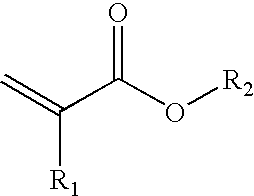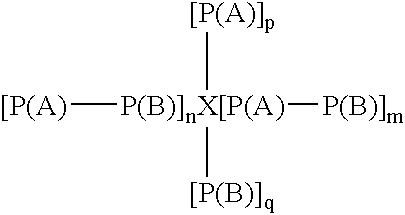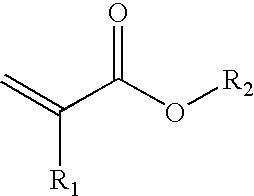Repulpable PSAs
a psas and psa technology, applied in the direction of film/foil adhesives, basic electric elements, electrical appliances, etc., can solve the problem of significant reduction of the tack of the polymer during adhesive bonding for a prolonged period, and achieve the effect of high splicing strength
- Summary
- Abstract
- Description
- Claims
- Application Information
AI Technical Summary
Benefits of technology
Problems solved by technology
Method used
Image
Examples
example 1
[0145]A 2 l reactor conventional for radical polymerization is charged under nitrogen with 40 g of acrylic acid, 40 g of 2-ethylhexyl acrylate, 1.2 g of bis-2,2′-phenylethyl trithiocarbonate regulator and 80 g of acetone. Heating is carried out to an internal temperature of 60° C. and the initial charge is initiated with 0.2 g of Vazo 67® (DuPont) in solution in 5 g of acetone. After a reaction time of 1.5 hours initiation is repeated with 0.2 g of Vazo 67® (DuPont) in solution in 5 g of acetone. After 5 and 7 hours of reaction the batch is diluted in each case with 50 g of acetone.
[0146]After a reaction time of 24 hours a sample is taken. Gel permeation chromatography (Test C) against polystyrene standards indicated MN=30 100 g / mol and MW=35 300 g / mol.
[0147]The polymerization is continued in the same reactor after a reaction time of 24 h. To the polymer are added 320 g of 2-ethylhexyl acrylate, 80 g of acetone and 20 g of isopropanol. After a reaction time of 24.75 hours initiation...
example 2
[0149]A 2 l reactor conventional for radical polymerization is charged under nitrogen with 80 g of acrylic acid, 160 g of DMF and 0.8 g of bis-2,2′-phenylethyl trithiocarbonate regulator. Heating is carried out to an internal temperature of 60° C. and the batch is initiated with 0.2 g of Vazo 67®) (DuPont) in solution in 5 g of DMF. After a reaction time of 48 hours the reaction mixture is cooled to room temperature and the DMF solvent (dimethylformamide) is distilled off on a rotary evaporator. Gel permeation chromatography (Test C) against polystyrene standards indicated MN=7 500 g / mol and MW=15 200 g / mol.
[0150]The polymerization is continued in the same reactor after 24 h. To the polyacrylic acid are added 80 g of 2-ethylhexyl acrylate, 160 g of acetone and 40 g of ethanol. At an internal temperature of 60° C. initiation is carried out with 0.1 g of Vazo 67® (DuPont), in solution in 5 g of acetone. After 24 hours initiation is repeated with 0.1 g of Vazo 67® (DuPont), in solution...
example 3
[0152]A 2 L reactor conventional for radical polymerization is charged under nitrogen with 80 g of acrylic acid, 160 g of DMF and 0.8 g of bis-2,2′-phenylethyl trithiocarbonate regulator. Heating is carried out to an internal temperature of 60° C. and the batch is initiated with 0.2 g of Vazo 67® (DuPont) in solution in 5 g of DMF. After a reaction time of 48 hours the reaction mixture is cooled to room temperature and the DMF solvent (dimethylformamide) is distilled off on a rotary evaporator. Gel permeation chromatography (Test C) against polystyrene standards indicated MN=7 500 g / mol and MW=15 200 g / mol.
[0153]The polymerization is continued in the same reactor after 24 h. To the polyacrylic acid are added 60 g of 2-ethylhexyl acrylate, 20 g of acrylic acid, 160 g of acetone and 30 g of ethanol. At an internal temperature of 60° C. initiation is carried out with 0.1 g of Vazo 67® (DuPont), in solution in 5 g of acetone. After 24 hours initiation is repeated with 0.1 g of Vazo 67® ...
PUM
| Property | Measurement | Unit |
|---|---|---|
| softening/glass transition temperature | aaaaa | aaaaa |
| softening/glass transition temperature | aaaaa | aaaaa |
| glass transition temperature | aaaaa | aaaaa |
Abstract
Description
Claims
Application Information
 Login to View More
Login to View More - R&D
- Intellectual Property
- Life Sciences
- Materials
- Tech Scout
- Unparalleled Data Quality
- Higher Quality Content
- 60% Fewer Hallucinations
Browse by: Latest US Patents, China's latest patents, Technical Efficacy Thesaurus, Application Domain, Technology Topic, Popular Technical Reports.
© 2025 PatSnap. All rights reserved.Legal|Privacy policy|Modern Slavery Act Transparency Statement|Sitemap|About US| Contact US: help@patsnap.com



